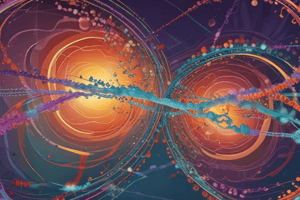Podcast
Questions and Answers
How are haloalkanes prepared from alkyl alcohols?
How are haloalkanes prepared from alkyl alcohols?
Haloalkanes can be prepared from displacement of alcoholic group in alkyl alcohol by halogen acid, PCl5 and PCl3.
What are allylic halides?
What are allylic halides?
Allylic halides have X bonded to the carbon atom adjacent to a C–C double bond.
What is the relative reactivity of alkyl halides for the same alkyl group?
What is the relative reactivity of alkyl halides for the same alkyl group?
RI > RBr > RCl > RF
How can vinylic halides be defined?
How can vinylic halides be defined?
What is dehydrohalogenation?
What is dehydrohalogenation?
What are some reagents that can be used for the Swarts reaction?
What are some reagents that can be used for the Swarts reaction?
How can alkyl halides be prepared from alkenes and alkynes?
How can alkyl halides be prepared from alkenes and alkynes?
What are benezylic halides?
What are benezylic halides?
What is the characteristic polarization of the carbon-halogen bond in alkyl halides?
What is the characteristic polarization of the carbon-halogen bond in alkyl halides?
What is the Saytzeff rule in dehydrohalogenation?
What is the Saytzeff rule in dehydrohalogenation?
What is the defining characteristic of allylic halides?
What is the defining characteristic of allylic halides?
How are haloalkanes commonly prepared from alkyl alcohols?
How are haloalkanes commonly prepared from alkyl alcohols?
Which reagent can be used for the Swarts reaction?
Which reagent can be used for the Swarts reaction?
What is the relative reactivity of alkyl halides for the same alkyl group?
What is the relative reactivity of alkyl halides for the same alkyl group?
What is the defining characteristic of benezylic halides?
What is the defining characteristic of benezylic halides?
How can alkyl halides be prepared from alkenes and alkynes?
How can alkyl halides be prepared from alkenes and alkynes?
What is the characteristic polarization of the carbon-halogen bond in alkyl halides?
What is the characteristic polarization of the carbon-halogen bond in alkyl halides?
What is dehydrohalogenation?
What is dehydrohalogenation?
'Saytzeff rule' states that in dehydrohalogenation, the hydrogen is removed from which carbon?
'Saytzeff rule' states that in dehydrohalogenation, the hydrogen is removed from which carbon?
What is the defining characteristic of vinylic halides?
What is the defining characteristic of vinylic halides?
Study Notes
Preparation of Haloalkanes
- Haloalkanes can be prepared from alkyl alcohols through a substitution reaction, where the hydroxyl group (-OH) is replaced by a halogen (-X).
- This reaction involves the use of a hydrogen halide (HX) such as HCl, HBr, or HI.
- The reaction is typically catalyzed by the presence of zinc chloride (ZnCl₂) or other Lewis acids.
Types of Alkyl Halides
- Allylic halides: Halides with a halogen atom bonded to a carbon atom that is adjacent to a carbon-carbon double bond.
- Benzyllic halides: Halides with a halogen atom bonded to a carbon atom that is adjacent to a benzene ring.
- Vinylic halides: Halides with a halogen atom bonded to a carbon atom that is part of a carbon-carbon double bond.
Reactivity of Alkyl Halides
- The reactivity of alkyl halides for the same alkyl group decreases in the order: I > Br > Cl > F.
- This is due to the increasing electronegativity of the halogen atoms, which affects the strength of the carbon-halogen bond.
Dehydrohalogenation
- Dehydrohalogenation is a reaction in which a halogen atom is removed from a haloalkane, resulting in the formation of an alkene.
- This reaction is the reverse of the addition of a halogen to an alkene.
Swarts Reaction
- The Swarts reaction is a method for preparing alkyl halides from alkyl alcohols using a reagent such as phosphorus halides (PX₃) or thionyl chloride (SOCl₂).
Preparation of Alkyl Halides from Alkenes and Alkynes
- Alkyl halides can be prepared from alkenes and alkynes through the addition of a halogen to the multiple bond.
Characteristics of Alkyl Halides
- The carbon-halogen bond in alkyl halides is polarized, with the carbon atom having a partial positive charge (δ+) and the halogen atom having a partial negative charge (δ-).
- The Saytzeff rule states that in dehydrohalogenation, the hydrogen is removed from the β-carbon (the carbon atom that is beta to the leaving group).
Studying That Suits You
Use AI to generate personalized quizzes and flashcards to suit your learning preferences.
Description
Test your knowledge of allylic, benzylic, and vinylic halides with this quiz. Learn about the characteristics and preparation methods of these types of halides.





